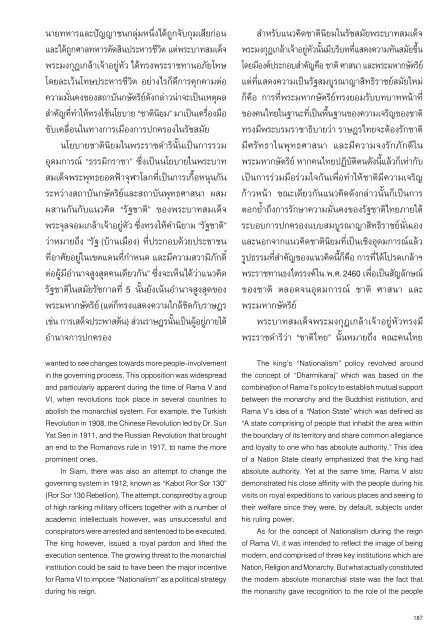บ้านเรือนถิ่นไทยในช่วงเจ็ดทศวรรษ 2489-2559
Create successful ePaper yourself
Turn your PDF publications into a flip-book with our unique Google optimized e-Paper software.
นายทหารและปัญญาชนกลุ่มหนึ่งได้ถูกจับกุมเสียก่อน<br />
และได้ถูกศาลทหารตัดสินประหารชีวิต แต่พระบาทสมเด็จ<br />
พระมงกุฎเกล้าเจ้าอยู่หัว ได้ทรงพระราชทานอภัยโทษ<br />
โดยละเว้นโทษประหารชีวิต อย่างไรก็ดีการคุกคามต่อ<br />
ความมั่นคงของสถาบันกษัตริย์ดังกล่าวน่าจะเป็นเหตุผล<br />
สำคัญที่ทำให้ทรงใช้นโยบาย “ชาตินิยม” มาเป็นเครื่องมือ<br />
ขับเคลื่อนในทางการเมืองการปกครองในรัชสมัย<br />
นโยบายชาตินิยมในพระราชดำรินั้นเป็นการรวม<br />
อุดมการณ์ “ธรรมิกราชา” ซึ่งเป็นนโยบายในพระบาท<br />
สมเด็จพระพุทธยอดฟ้าจุฬาโลกที่เป็นการเกื้อหนุนกัน<br />
ระหว่างสถาบันกษัตริย์และสถาบันพุทธศาสนา ผสม<br />
ผสานกันกับแนวคิด “รัฐชาติ” ของพระบาทสมเด็จ<br />
พระจุลจอมเกล้าเจ้าอยู่หัว ซึ่งทรงให้คำนิยาม “รัฐชาติ”<br />
ว่าหมายถึง “รัฐ (บ้านเมือง) ที่ประกอบด้วยประชาชน<br />
ที่อาศัยอยู่ในเขตแดนที่กำหนด และมีความสวามิภักดิ์<br />
ต่อผู้มีอำนาจสูงสุดคนเดียวกัน” ซึ่งจะเห็นได้ว่าแนวคิด<br />
รัฐชาติในสมัยรัชกาลที่ 5 นั้นยังเน้นอำนาจสูงสุดของ<br />
พระมหากษัตริย์ (แต่ก็ทรงแสดงความใกล้ชิดกับราษฎร<br />
เช่น การเสด็จประพาสต้น) ส่วนราษฎรนั้นเป็นผู้อยู่ภายใต้<br />
อำนาจการปกครอง<br />
wanted to see changes towards more people-involvement<br />
in the governing process. This opposition was widespread<br />
and particularly apparent during the time of Rama V and<br />
VI, when revolutions took place in several countries to<br />
abolish the monarchial system. For example, the Turkish<br />
Revolution in 1908, the Chinese Revolution led by Dr. Sun<br />
Yat Sen in 1911, and the Russian Revolution that brought<br />
an end to the Romanovs rule in 1917, to name the more<br />
prominent ones.<br />
In Siam, there was also an attempt to change the<br />
governing system in 1912, known as “Kabot Ror Sor 130”<br />
(Ror Sor 130 Rebellion). The attempt, conspired by a group<br />
of high ranking military officers together with a number of<br />
academic intellectuals however, was unsuccessful and<br />
conspirators were arrested and sentenced to be executed.<br />
The king however, issued a royal pardon and lifted the<br />
execution sentence. The growing threat to the monarchial<br />
institution could be said to have been the major incentive<br />
for Rama VI to impose “Nationalism” as a political strategy<br />
during his reign.<br />
สำหรับแนวคิดชาตินิยมในรัชสมัยพระบาทสมเด็จ<br />
พระมงกุฎเกล้าเจ้าอยู่หัวนั้นมีบริบทที่แสดงความทันสมัยขึ้น<br />
โดยมีองค์ประกอบสำคัญคือ ชาติ ศาสนา และพระมหากษัตริย์<br />
แต่ที่แสดงความเป็นรัฐสมบูรณาญาสิทธิราชย์สมัยใหม่<br />
ก็คือ การที่พระมหากษัตริย์ทรงยอมรับบทบาทหน้าที่<br />
ของคนไทยในฐานะที่เป็นพื้นฐานของความเจริญของชาติ<br />
ทรงมีพระบรมราชาธิบายว่า ราษฎรไทยจะต้องรักชาติ<br />
มีศรัทธาในพุทธศาสนา และมีความจงรักภักดีใน<br />
พระมหากษัตริย์ หากคนไทยปฏิบัติตนดังนี้แล้วก็เท่ากับ<br />
เป็นการร่วมมือร่วมใจกันเพื่อทำให้ชาติมีความเจริญ<br />
ก้าวหน้า ขณะเดียวกันแนวคิดดังกล่าวนั้นก็เป็นการ<br />
ตอกย ้ำถึงการรักษาความมั่นคงของรัฐชาติไทยภายใต้<br />
ระบอบการปกครองแบบสมบูรณาญาสิทธิราชย์นั่นเอง<br />
และนอกจากแนวคิดชาตินิยมที่เป็นเชิงอุดมการณ์แล้ว<br />
รูปธรรมที่สำคัญของแนวคิดนี้ก็คือ การที่ได้โปรดเกล้าฯ<br />
พระราชทานธงไตรรงค์ใน พ.ศ. 2460 เพื่อเป็นสัญลักษณ์<br />
ของชาติ ตลอดจนอุดมการณ์ ชาติ ศาสนา และ<br />
พระมหากษัตริย์<br />
พระบาทสมเด็จพระมงกุฎเกล้าเจ้าอยู่หัวทรงมี<br />
พระราชดำริว่า “ชาติไทย” นั้นหมายถึง คณะคนไทย<br />
The king’s “Nationalism” policy revolved around<br />
the concept of “Dharmikaraj” which was based on the<br />
combination of Rama I’s policy to establish mutual support<br />
between the monarchy and the Buddhist institution, and<br />
Rama V’s idea of a “Nation State” which was defined as<br />
“A state comprising of people that inhabit the area within<br />
the boundary of its territory and share common allegiance<br />
and loyalty to one who has absolute authority.” This idea<br />
of a Nation State clearly emphasized that the king had<br />
absolute authority. Yet at the same time, Rama V also<br />
demonstrated his close affinity with the people during his<br />
visits on royal expeditions to various places and seeing to<br />
their welfare since they were, by default, subjects under<br />
his ruling power.<br />
As for the concept of Nationalism during the reign<br />
of Rama VI, it was intended to reflect the image of being<br />
modern, and comprised of three key institutions which are<br />
Nation, Religion and Monarchy. But what actually constituted<br />
the modern absolute monarchial state was the fact that<br />
the monarchy gave recognition to the role of the people<br />
187


















